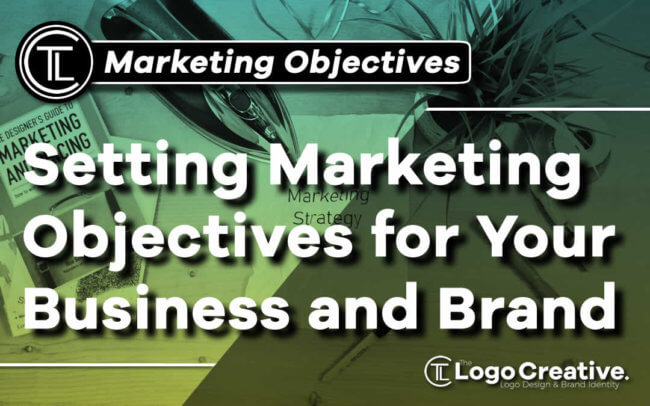In this article we share How to Set Marketing Objectives for Your Business and Brand. Read on to learn how it’s done.
“Your brand is what other people say about you when you’re not in the room.”
You’ve probably heard this clever and witty saying that perfectly illustrates the essence of having a strong brand. It comes from Jeff Bezos, Founder of Amazon, and currently the richest person in the world. So, it’s safe to assume that he’s right.
If you want to grow your business and brand, it’s crucial to know how to do that, meaning that you need a very detailed plan.
Setting marketing objectives is the skeleton of this plan and your overall marketing strategy, and that’s why you should carefully work on this task.
In this guide, we’ll discuss what marketing objectives are, how to set and measure them, as well as provide some examples of these objectives that you can use in your strategy.
Table of Contents
What Are Marketing Objectives?
While objectives and goals are used interchangeably in many other contexts, in this case, we’ll have to distinguish between them.
Marketing objectives have the purpose of supporting your company’s goals and helping your team understand how to better reach and measure them, as well as how their specific actions impact business outcomes. Their role is to direct your marketing team in the right direction and help them set commercial targets.
Marketing goals are company-wide, and they should shape your overall marketing strategy.
For example, if your marketing goal is to increase product awareness, marketing objectives can be reaching out to 1,000 new people weekly by email or some other channel.
When your objectives are properly set, it’s much easier to think of some ideas that will improve a certain metric, thus managing to influence the end goal and achieve it.
Finally, key performance indicators (KPIs) have the purpose of helping you stay on the right track. These metrics allow you to monitor your team’s performance and determine whether your objectives have been met.
Examples of Marketing Objectives
Here’s a list of marketing objectives set to support particular marketing goals. Specific KPIs necessary to keep track of how your efforts are performing are aligned with every goal.
1. Goal: Increase brand awareness
No matter whether you’re just starting your business or you want to reach a new target audience, brand visibility and awareness play an important role.
In order to establish a strong online presence and make your brand more recognizable, you can ramp up your content marketing and social media activities.
If we bear in mind that marketers who prioritize content marketing are 13 times more likely to experience a positive return-on-investment, it’s clear that investing in this strategy can really pay off. It’s recommended that small blogs publish 1-2 new posts weekly to boost brand awareness, while bigger ones can see growth in this department with 3-4 new and republished posts.
Content marketing goes hand in hand with search engine optimization, and the performance of your blog posts heavily relies on how well they rank on Google. SEO can boost your rankings as well as your visibility and awareness.
Use different KPIs to measure the effectiveness of your efforts, such as the growth in direct traffic or your backlink success.
When it comes to social media, KPIs to monitor are the number of clicks on paid ads, organic traffic, and the number of social mentions.
2. Goal: Generate high-quality leads
Not all leads are made equal, which means that lead generation shouldn’t be a numbers game.
Fewer high-quality leads will do much more for your profit than having an abundance of low-quality leads sitting in your CRM. This way, you’ll supply your sales team with prospects that they can nurture and turn into paying customers more easily.
Creating targeted and well-optimized content is an indispensable objective for achieving this goal. Blog posts and other types of content such as how-to guides, videos, infographics, white papers, and industry reports will attract leads interested in what you have to offer.
Email outreach is another strategy that works well. By sending out personalized and highly granular campaigns, you’ll be able to attract the right crowd.
Conversion rate is a KPI to measure in both cases, as well as an increase in booked demos.
3. Goal: Accelerate your sales cycle

Although your sales team is mainly in charge of this goal, marketers can join in and lend a hand.
Namely, by delivering the right and timely messaging, content, and materials to potential customers, your marketing team will help move them down the funnel more smoothly.
KPIs that you should pay attention to are the ones related to sales enablement content and materials.
In other words, monitor whether an increase in the number of your relevant educational content pieces will result in an increase in the number of conversions. Also, the more product/feature pages, the shorter your sales cycle will be.
4. Goal: Retain existing customers
Your work doesn’t end after you’ve managed to convert a prospect into a customer.
Stats say that a 5% increase in customer retention results in at least a 25% increase in profit, so it’s clear that keeping your existing customers is of vital importance for the success and survival of your business.
Your marketing objective can be to encourage upselling and cross-selling, as that’s how you’re going to increase your repeat purchase rate.
You can implement a number of activities that will prevent existing customers from churning and build loyalty. For example, offering a loyalty program or introducing a recommendation engine that will show them complementary products can do wonders.
As for the KPIs, your customer’s lifetime value is worth keeping track of.
5. Goal: Improve customer experience
By the end of 2020, customer experience will overcome product and price as the key brand differentiator, so it should be a focal point of your marketing strategy.
When it comes to the objectives with which you can facilitate achieving this goal, you can work towards improving your customer support. This means allowing your customers and potential customers to get in touch with you through different channels, including social media, IMs, phone, or chat.
This means leveraging chatbots capable of handling multiple queries simultaneously, which brings us to a relevant KPI – customer service response times. If your customers can get their questions answered or issues resolved right away, they will be satisfied and more likely to continue doing business with your brand.
6. Goal: Improve customer advocacy
Promoting your brand can’t rely solely on your own efforts.
Consumers are more likely to trust their peers than brands, which is why you need to have the support of your loyal customers if you want to be trusted and credible.
There are numerous ways to leverage customer advocacy and turn your customers into your brand ambassadors. It’s a good idea to ask for and incentivize customer reviews, case studies, or testimonials. Just make sure that they’re genuine and authentic because if they’re fake or staged, they can trigger a backlash and ruin your reputation.
A KPI to monitor can be the number of reviews and other kinds of social proof on your own or other websites.
It’s worth mentioning that you can’t achieve your goals and objectives without a well-defined budget. You need to know how much money you have available for your marketing activities and efforts. That’s why your first step should be finding an experienced accountant, as well as advanced accounting tools, to help you manage your finances and prevent you from going into the red.
Setting Your Marketing Objectives
If you want to set your marketing objectives properly, it’s essential to opt for a SMART approach. This acronym stands for specific, measurable, achievable, relevant, and time-bound. This way, you can be sure that your marketing team will be able to manage these objectives successfully as well as identify new ones.
- Specific means that your objectives should be outlined very clearly and so that every team member understands their importance as well as what actions should be taken in order to accomplish them.
- Measurable means that your objectives have KPIs and benchmarks with which you can monitor your team’s performance and success in achieving them.
- Achievable means that your objectives have to be possible to attain. Setting up the bar too high will discourage your team, so it’s important to find the sweet spot and make your objectives challenging enough but, at the same time, realistic.
- Relevant refers to the capacity of your objectives to improve your business. In other words, every objective has to make sense and be aligned with what you want to achieve.
- Time-bound means that your objectives have to be put within a timeframe. Setting a deadline is extremely important because that way you’ll know whether your efforts have been successful.
Steps Towards Setting Your Objectives
After discussing all the technical details you need to know before setting your objectives, it’s time to talk about how exactly you can define your objectives.
Here are a couple of necessary steps to take during this process.
1. Think about your mission statement
Your business mission statement is at the core of your overall marketing strategy – it drives all the activities towards meeting the end goal of your business.
A mission statement answers three critical questions related to the purpose of your business:
- Who are you?
- What do you do?
- Why do you do what you do?
By revisiting this important document, you’ll be able to understand what you should focus on in order to serve your audience.
2. Do your research
Setting your objectives requires you to understand your audience, industry, market, trends, and tools, thus prioritizing what the essential areas of your business are.
This refers to relevant channels, platforms, and tactics that your business has to leverage.
In other words, when you identify who your target customers are, you’ll determine what social media networks to use, what channels of communication are most suitable, as well as what marketing strategies will work.
3. Make the most of your data

When it comes to setting objectives, collecting and making sense of your customer data is a must.
Data and analytics are among the top elements of every marketing strategy for the following reasons:
- With data, you can optimize and adjust every stage of your funnel, all the way from attracting your customers to re-engaging them.
- Data will help you stay on top of your marketing efforts. Your competitors are using it, meaning that you should too.
- Data allows marketers to corroborate and justify their plans and goals. That’s how they can show that their efforts are working.
Here’s a five-step marketing strategy with which you can structure and shape your objectives:
- Research and identify your audience and identify their interests, pain points, behaviors, and needs.
- Set your data-driven objectives based on what you’ve learned about your audience and make them SMART.
- Determine your KPIs before starting with your activities.
- Keep track of your metrics and analyze your performance when you launch your campaigns. Collect additional data if necessary, and adjust your activities based on what you find out in the process.
- Analyze and evaluate your performance. Avoid jumping to any conclusions. Instead of that, analyze your metrics, try to figure out what works and why, and try to implement your findings to improve your campaigns and overall performance.
4. Match your marketing objectives to your funnel
Aligning your marketing objectives to your marketing funnel will help you convert your potential customers.
A marketing funnel usually consists of 6 stages – awareness, interest, consideration, intent, evaluation, and purchase. Every stage requires relevant marketing activities so that potential customers can be moved on to the following one. This strategic alignment can be efficiently facilitated with the expertise of a virtual CMO, ensuring a cohesive and effective marketing approach.
Examples of the objectives for each stage can be:
- Awareness: Drive 5,000 visits for every blog post/Reach 1,000 people with a Facebook post
- Interest: Obtain 3,500 new subscribers a month/ Obtain 1,000 new Facebook followers a month
- Consideration: Acquire 50% more customers from demos
- Intent: Call 50 new prospects a week
- Evaluation: Book 20 demos with highly qualified leads a month
- Purchase: Convert 80% calls into purchases.
Setting SMART marketing goals and objectives will benefit your business significantly. Without this process, you and your team won’t be able to identify what you’re doing right and whether you’re progressing towards where you want to be. What are your biggest challenges when it comes to setting marketing objectives?
Join The Logo Community
We hope you have enjoyed this article about How to Set Marketing Objectives for Your Business and Brand. If you would like more personal tips, advice, insights, and access to our community threads and other goodies join me in our community. You can comment directly on posts and have a discussion.
*TIP – We recommend Skillshare to learn online. There are tons of classes for everything including marketing related courses. Get a free 2 months with our link and you won’t regret it Trust us!
Author Bio
Michael has been working in marketing for almost a decade and has worked with a huge range of clients, which has made him knowledgeable on many different subjects. He has recently rediscovered a passion for writing and hopes to make it a daily habit. You can read more about Michael’s work at Qeedle.


